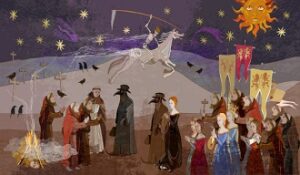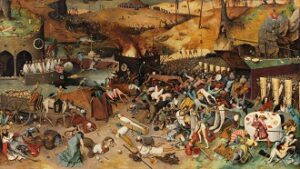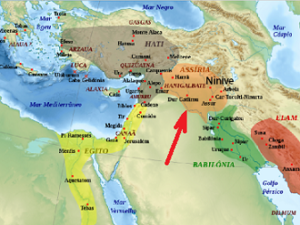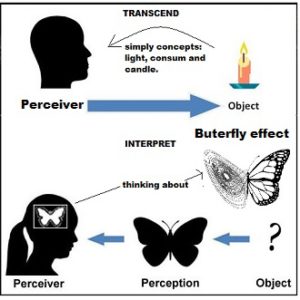
Arquivo para a ‘Libraries’ Categoria
History, the great clearing and parousia
Christmas is near and the birth of Jesus is a historical fact because the Census ordered by the emperor of Rome Caesar Augustus, regarding the date there is controversy for it would be between 4-5 BC, when Quininus was Governor of Syria as described in the Bible (Lc 2.2), but it is certain that the census was carried out and this was precisely the reason why Mary and Joseph went to Bethlehem, where the prophecy said that from there the savior would be born, and thus he “was numbered among men”.
the Census ordered by the emperor of Rome Caesar Augustus, regarding the date there is controversy for it would be between 4-5 BC, when Quininus was Governor of Syria as described in the Bible (Lc 2.2), but it is certain that the census was carried out and this was precisely the reason why Mary and Joseph went to Bethlehem, where the prophecy said that from there the savior would be born, and thus he “was numbered among men”.
History is also punctuated by divine interventions, in the decadence of Rome the monasteries were born, where the culinary culture, the first guilds and offices and also an earlier stage of printed writing is carried out, through the copyists, the first schools and later the first universities, with a strong theological influence as it could not be otherwise, but this is all history, also in the renaissance art and culture had a strong influence (theological).
We enter modernity, the work that we read punctually in this week’s posts “all in the same boat” by Sloterdijk, mentions an important fact, in addition to citing the classic work of the Decamerão by Boccaccio as “small community in the midst of the big disaster” ( Sloterdijk, 1999, p. 75), makes an analysis of the Black Death (which happened in the 130’s) and which devastated Europe with more than 100 million people dead when the population was much smaller than today, and its political influence.
In a footnote he cites the work of Henrik Siewierki (translated by Estação Liberdade in 2001) “A mass for the city of Arras” where he analyzes the psychological and political consequences of the plague, also the psychologist Franz Renggli, in his book Self-destruction by abandonment , developed the hypothesis of the influence on modernity of the plague, and also of the degradation of the mother-child relationship that would have caused a kind of immunological, collective and psychosomatic weakness that favored the virus of that plague.
All this analysis is interesting in the midst of the Pandemic’s return to Europe, while it is undoubtedly a scourge, it can fuel a new clearing on our community, that is, the idea of a mutual and solidary defense in view of a catastrophe even greater than the one we’ve already encountered.
All this analysis is interesting in the midst of the Pandemic’s return to Europe, while it is undoubtedly a scourge, it can fuel a new clearing on our coimmunity (category of Sloterdijk), that is, the idea of a mutual and solidary defense in view of a catastrophe even greater than we have already encountered.
It serves to “make the paths smooth”, as the biblical reading says when John, the son of Zechariah and Elizabeth, announced in the desert using the words of the prophet Isaiah: “this is the voice of the one who cries out in the desert: ‘prepare the way of the Lord , make your paths straight’” (Lk 3,4) and it seems favorable to our time of scourge and desert.
It is important to remember that the first two weeks of Christmas celebrate not the coming of Jesus in Bethlehem, but the Parusia, that is, the preparation for his second coming.
Falling, but the pandemic is not over
We mentioned last week the concern about evolving cases in some countries such as Russia and England, where a variant of the virus is being studied with concern, also the poorest countries have received fewer vaccines than promised by donation, and we already understand that Pandemic is global, that is, there is an influence of less vaccinated regions in others that maintain a high level of immunity, policies for future pandemics already take these factors into account.
some countries such as Russia and England, where a variant of the virus is being studied with concern, also the poorest countries have received fewer vaccines than promised by donation, and we already understand that Pandemic is global, that is, there is an influence of less vaccinated regions in others that maintain a high level of immunity, policies for future pandemics already take these factors into account.
Some countries continue with a high level of deaths, despite vaccination, in the US around 1700 daily deaths in the last week, in the rest of the world it is falling, but with the presence of deaths, in the graph above with deaths registered on the 23/ 10 (Saturday) in absolute number of deaths, Brazil, followed by India, Mexico and then Russia.
The major concern of WHO is with respect to promises of vaccine donations to the poorest countries that are not being fulfilled. the news is not from this blog, but from the WHO itself, as it has positioned itself against the third dose, as according to The People’s Vaccine report made on the BBC, an alliance of a charity institution reported that only one in seven doses of vaccines promised by companies and rich countries, in fact reached the poorest nations.
In the report, in the interview with Bruce Aylward he stated: “Do we really need to step up or do you know what’s going to happen? This pandemic will last another year than it needs to,” he warned, and this is due to the fact that even with isolation measures we are always connected, and any communication (not only of people, but of products and any biological material such as fruits and food) can be transmitter.
In Brazil, the number of vaccine doses is coming, a boost in the vaccination campaign against Covid 19, a batch of 1.7 million Pfizer/BioNTech vaccines arrived on Friday (10/22) and other equal amounts had already arrived, totaling almost 5 millions of vaccines.
The inputs for AstraZeneca were also received by FioCruz (Brazil), which produces the vaccine in the country, the landing of the Active Pharmaceutical Ingredient (API) arrived for the production of 5.6 million doses with arrival scheduled for 5:50 am on Sunday morning (25/10).
Vaccination in the first dose reaches close to 153 million doses, while the second dose (or single dose) reached just over 109 million vaccinated, the moving average of deaths is just above 300 daily deaths, with a downward trend we can assume that we will be below 100 daily deaths in early December.
Mass culture and its criticism
In Morin’s book “The Mass Culture of the Twentieth Century”, it is stated that there is a zone “where the distinction between culture and mass culture becomes purely formal: The Human Condition, Nausea or The Plague enters the culture of mass without, however, leaving the cultivated culture” (Morin, 1997, p. 53) and Camus’ book is interesting for its coincidence with the issue of the current Pandemic, and interesting that it did not enter into the analysis of the cultural aspect of the moment.
it is stated that there is a zone “where the distinction between culture and mass culture becomes purely formal: The Human Condition, Nausea or The Plague enters the culture of mass without, however, leaving the cultivated culture” (Morin, 1997, p. 53) and Camus’ book is interesting for its coincidence with the issue of the current Pandemic, and interesting that it did not enter into the analysis of the cultural aspect of the moment.
We have already posted on the blog at another time about Camus’ book “The Myth of Sisyphus” and oher about José Saramago’s novel Essay on blindness (1995), although widely read in some European countries amidst the pandemic, his analysis was not entered the circles of cultural “high narrative”, that we tried to explain in some posts this week.
Written in 1947 by the weak Algerian Alberto Camus, its origin is important, because its chronicle starts from an analysis of an epidemic that occurred in the Algerian city of Oran, in some year of the 1940s, when Camus worked clandestinely in the clandestine newspaper “ Combat!” where he wrote texts engaged against Nazism, among them “Letters to a German Friend” (1945) stand out.
The book deals with the absurdity of existence, when in the midst of an epidemic there is a lack of love and human solidarity, whose feelings can be summarized where he wrote: “There were common feelings, such as separation or fear, but the personal concerns.
No one had yet truly accepted the disease”. Another excerpt that can be highlighted: “Many continued to hope that the epidemic would cease and that they, with their families, would be spared. As a result, they still didn’t feel obligated to do anything.
The plague was nothing more to them than an unpleasant visitor who would one day depart. Frightened but not desperate, the moment had not yet come when the plague would appear to them as the very form of their life and when they would forget the existence they had been able to lead until then.”
With the war just over in the period that he wrote the book, he remembers: “The scourges, in fact, are a common thing, but it’s hard to believe in them when they befall us. There were an equal number of pests and wars in the world. And yet, plagues, like wars, always find people equally unprepared.”
He shrewdly analyzes the scourges in history: “From the beginning of history, the scourges of God have brought the proud and the blind at his feet. Meditate on this and I fell to my knees.” and adds: “Oh, if it were an earthquake! A good shake, and there was no more talk about it… counting the dead, the living, and that was it. But this damn disease! Even those who don’t catch it seem to carry it in their hearts.”, and his conclusion brings a reflection: “The more the pandemic spreads, the more the moral will become elastic.”
I understood that the absence of solidarity and compassion, as well as the elasticity of morality were not unusual facts in epidemics, but somewhat expected, but I would add that there is always a more humane, more solidary alternative that gives us the hope of a much more just after a sad scourge, learn something from it.
Falling, but care must be taken
After a legendary pandemic fall in Brazil, Saturday the curve was below 500 deaths in the last 24 hours, the deaths reaching almost 600 thousand since the beginning of the pandemic, indicate that there is still danger and the flexibility that is already happening for massive public events is worrisome.
was below 500 deaths in the last 24 hours, the deaths reaching almost 600 thousand since the beginning of the pandemic, indicate that there is still danger and the flexibility that is already happening for massive public events is worrisome.
It’s important to remember that on September 13th the moving average was 465.’ and then it went up.
We already explained last week that a “aftermath” is needed and that the proximity of the holidays and the end of the year can worry us, I remember the case of Portugal last year, which relaxed on these dates and had an increase in January, the countries that are in the beginning of flexibilization have really low rates of infection and mortality and the regions of contagion are observed.
The vaccination of the first dose already 40% (93,271,450 immunized and 147 million first doses), the vaccine delay rate in Brazil is 11%, according to the bulletin VigiVac of the Oswaldo Cruz Foundation, Brazil.
The Bulletin points out the states with the greatest delay, Ceará with 33% and the smallest Rio Grande do Norte with 5.4%, also note the absence for the second dose, in absolute numbers, São Paulo 1.25 million, in Rio de Janeiro 956.9 thousand people did not show up for the second dose and in Bahia 907.5 thousand people, the State with the highest vaccination is São Paulo with 79.20% in the first dose when it is not the only one and the lowest is Pará with 50, 91% took a dose.
Vaccines also had delays in delivery, Coronavac 33%, AstraZeneca 15% and Pfizer with a lower rate of 1%, which is why it has been the most applied in many cases in the third dose.
Pfizer entered more than 1 million doses this Saturday at Viracopos airport and promises to deliver up to 10 million on four charter flights that will arrive in the next few days.
Flexibility should advance in reliable numbers, taking serious control measures, for example, isolation in sporting events, in shopping malls and in means of transport.
So the last ones will be the first ones
It doesn’t matter that you show that you do things well, that you keep up appearances, that you are always in a prominent place, even in politics and in religious services and celebrations, the real conscience is that the intention is linked, and the intentionality is the consciousness directed to “something”, says phenomenology.
up appearances, that you are always in a prominent place, even in politics and in religious services and celebrations, the real conscience is that the intention is linked, and the intentionality is the consciousness directed to “something”, says phenomenology.
So that the new normality, not that of the post-pandemic, but that of the post-civilization crisis and everything indicates that it is on its way, can reverse the logic of the wickedness of the powerful, the oppressors and the Pharisees, only true solidarity will count, only it will be able to sustain the new course, which may not come from a new normality, because it was already distant before the pandemic, just read the serious literature that is not that of the media.
The fragile and the defenseless have become even more fragile in the pandemic, but the logic of power will be inverted by an aortic phenomenology, that which comes from the inorganic over the organic, comes from nature to the human, and from the cosmos to the planet, as stated Morin in his “introduction to complexity” the whole is in the part, the cosmos and nature in each individual, as the part is in the whole, we are responsible for everything that happens in Nature.
It is in cosmology and not in the systemic view, it is in aorganic holism and not in Cartesian holism, it is in mystique and not in pharisaism or ideology linked to religion, which is another type of religion without asceticism, the change comes from a long night of humanity, but you can concentrate on a visible night.
The poet Hölderling stated “where there is fear there is salvation”, and the moment of apprehension of humanity waiting for a vaccine must think of a vaccine that will remove the blindfold from the blindness of thought, Edgar Morin advocated this evening, and Peter Sloterdijk stated that it is not a favorable time for the exercise of thought, we are petrified in systemic and doctrinal logic that does not allow us to perceive a new one over the horizon.
That is why the last will be the first, simple people have the intuition of this possible change, the true sages want it, not as the powerful want it, but as the fragments of the social pandemic, irrational doctrine and closed in their bubble´s dream .
Those who blaspheme against religions affirm as the prophet Ezekiel said in the old testament (Ezek. 18,25): “You are saying: the Lord’s conduct is not correct. Hear, you of the house of Israel. Is it my conduct that is not correct, or is it your conduct that is not correct? “, the humbles can understand.
This is how the last will be the first, and the workers of the last hour will be, as the biblical parable says, those who called at the end of the day went to work and received the same payment as those who arrived at the beginning of the day, had not just gone because they had not been called (Mt 21: 28-32).
It is not a cIt is not a crisis of thought alone
The crisis may seem like something too intellectual, thinking would be far from the concrete reality of science, and thus from ordinary life, but its extension reaches the everyday science from statistics to medicine, from bibliometrics to biology and this can affect confidence in science and in In the spiritual field there is an immense openness to quackery and the manipulation of good faith.
the concrete reality of science, and thus from ordinary life, but its extension reaches the everyday science from statistics to medicine, from bibliometrics to biology and this can affect confidence in science and in In the spiritual field there is an immense openness to quackery and the manipulation of good faith.
This criticism questioned, for example, the fact-value dichotomy, emphasizing the social construction of facts, and can be traced back to the works of philosophers like Friedrich Nietzsche and Edmund Husserl, with their rejection of science as a metaphysical substitute.
Stephen Toulmin was very articulate in his criticism of the Cartesian idea of rationality (1958), while the essence of the scientific method has been the subject of writings (and disputes) by authors such as Karl Popper, Thomas Kuhn, Paul Feyerabend and Imre Lakatos.
The essence of the scientific method has been the subject of writings (and disputes) by authors such as Karl Popper, Thomas Kuhn, Paul Feyerabend and Imre Lakatos, the echo of these disputes reaching the world of physics as the debate about string theories and their physical reality.
An interesting literature on the current crisis was the work of Derek of Solla Price “Little Science, Big Science” of 1963, he states that there is a point of saturation and senility, which was the result of the exponential growth he experienced in the 20th century.
Another more interesting work is the book by Jerome Ravetz “Scientific knowledge and its social problems”, which offers a critique of the myths of objectivity (it is our main object of this blog), and which asks about the solution of practical problems, that is , social.
In a recent work he recently argued Ravetz (2016) that “Applying a” scientific “methodology to science governance tasks leads directly to corruption, as any system can be at stake”, in another article, Ravetz (2011) defines the issue in terms of the “maturation of the structural contradictions of modern European society”.
The pandemic showed the inefficiency of both the medical field where “specialists” defend medicines that have not been proven effective and generate collateral problems, such as hydroxychloroquine and others (according to the magazine Veja (in section Saude), 69 medicines are tested: 18 are anticancer, 14 immunosuppressants, 13 antihypertensive drugs, 12 antiparasitic drugs and 12 anti-inflammatory drugs, and statistical treatment also hide the real results, as are the analyzes of the evolution of the pandemic in Brazil
References:
De Solla Price, D. J. (1963). Little science big science. Columbia University Press.
Ravetz, J. R. (1971). Scientific knowledge and its social problems. Oxford University Press.
Ravetz, J. (2008). Faith and reason in the mathematics of the credit crunch. The Oxford Magazine. Eight Week, Michaelmas term 14–16, Available online at http://www. pantaneto.co.uk/issue35/ravetz.htm.
Ravetz, J. R. (2011). Postnormal Science and the maturing of the structural contradictions of modern European science. Futures, 43, 142–148.
Ravetz, J. R. (2016). How should we treat science’s growing pains? The Guardian 8 June 2016.
Toulmin, S. E. (1958) The Uses of Argument, UK: Cambridge University Press.
The pandemic and the sign of Jonah
Nínive (present-day Mossum) was one of the largest cities during the Assyrian reign, by the standards of the time it had more than 100,000 inhabitants and was quite extensive since the Bible reveals that Jonas took 3 days to explore it and ask for the change of conduct of its inhabitants.
reign, by the standards of the time it had more than 100,000 inhabitants and was quite extensive since the Bible reveals that Jonas took 3 days to explore it and ask for the change of conduct of its inhabitants.
The date on which the preaching took place in Nineveh is uncertain and the author of the book that bears the name of this prophet is also unknown, but as it refers to the reign of Jeroboam II as king of Israel, the date must be between the years 700 and 742 BC, by writing the text in Aramaic typical of late Hebrew, both in style and in grammar, it is post-exile which means between 722 and 742 BC
From the end of the 17th century BC (when the Neoassirian Empire fell), until the middle of the 7th century, it was a geopolitical entity, ruled by other peoples, the Assyrians were known for their wickedness and violence, where they could even kill for debt, and the biblical narrative said that the prophet Jonah, who was to preach and ask for the change and conversion of the people, was afraid to do his mission.
It is not known for sure what was the plague that could come to the people there, but the people including the king all changed their attitude and converted, and the plague did not happen in that region, the current pandemic already has its sign of changing habits and the demand for solidarity with everyone, but there are still those who think that the pandemic will pass without any change in attitude.
The history books do not record exactly what the change was, but it was during the government of Assurbanipal, son Assaradão, who died in 667 BC, that Assiria lived its most profitable period, including the first Library of history, precisely the Library of Nineveh, which is where thousands of texts are found (chronicles, royal letters, decrees, religion, myths and many others) written on a baked clay tablet.
The change that we need not only to avoid the number of deaths that grows, ranges from personal habits to the concern with food and life maintenance of those who no longer had jobs, those who now do not have and those who must lose with the growth of pandemic.
For those who believe, they must also rethink what they believe and experience what they believe, otherwise it is just a legend or fable told as a beautiful story.
Simplification, idealism and pandemic
The idea that we can simplify phenomena that are complex seems a good way, but to simplify what is by nature complex is to ignore the set of phenomena and interpretations that are within the phenomenon you want to analyze, whatever the nature.
but to simplify what is by nature complex is to ignore the set of phenomena and interpretations that are within the phenomenon you want to analyze, whatever the nature.
It is very different from the search for essence, the pre-Socratics sought to define what was the essential element of nature: fire, air, atoms, numbers, the Being, and thus defined the main pre-Socratic schools, when realizing that it was a broader phenomenon Socrates, which is read by Plato divides into two worlds: the world of Ideas and the sensitive world, however any attentive reader will not say that his school has simplified, it only paved the way for greater complexity.
The eidos of Plato and the pre-Socratic Parmenides is different from modern idealism, because in it there is so much the concept of form, for example, a chair whatever form it has its Being as being made to sit.
The Greek eidos from which the etymology of the word idea comes, has two accepted meanings, one that is a synonym for concept, but in a broader sense it is thought of as an expression, with the implicit principle of the idea of intentionality (*), and this concept it was only taken up in modern philosophy by Franz Brentano and later in Husserl’s phenomenology, who was his student.
Modern idealism, whose fundamental basis is Kant, although it has a common part to the Greek eidos, which is the idea that when studying the thing we have a projection of knowledge on it, reducing the idea that this study would be what characterizes the object of study (objectivity), and thus introduces a specific type of subjectivity, abstracting it from Being, this abstraction has in Hegel the apex.
Kant came to think that it would be possible to reduce all thought to a few concepts, it would be a great facilitator for study and thought, but his thinking resulted in an even greater complexity, and his simplicity fell into the subject x object dualism, which we suffer.
Every simplification leads to some kind of subjectivism or objectivism, even in religious terms, when studying The Human Phenomenon, Teilhard Chardin declared that Man is the complexification of nature, difficult for theologians and exegetes to accept, but I ask you the question: why did Jesus use of parables to explain things that apparently could be simple¬, because it isn’t.
Idealism is basically a “doctrine” that contains the belief that it is thought and not the physical world that is at the origin of all things, that is, the objective world, which we discover with the pandemic, and physics quantum already knew and actual cosmology is deepening, is that uncertainty is part of knowledge, and we are faced every day with a new phenomenon.
After all, one of the assumptions of Kantian idealism was the submission of nature, she rebelled.
This is the original novelty that idealists do not accept, and this novelty should give us back the humility, proclaimed by all, but as idealism gets stuck in duality, the error is the others, we knew the truth, not even science, nor faith could imagine the complexity of the phenomenon that all humanity lives, the first step to face the pandemic is this: I depend on the step of the Other, and that we can take steps together, it still seems difficult.
*Encyclopædia Britannica, Available in: https://www.britannica.com/topic/idea , Access in: 04/26/2020.
In-formation and modern state
It is impossible to think about the modern state, without thinking about its laws and the social contract that is established from them, and it is not by chance that they arise after the Gutenberg press (and the book).
One can think in an equally naive way that this is just theory, it is easy to demonstrate  that it is not the form of action of the polis, it is impossible to think without the Greek polis, and the thoughts ranging from the pre-Socratic to the modern contractualists : Thomas Hobbes, John Locke and the Swiss (he was not French) Jean Jacques Rousseau.
that it is not the form of action of the polis, it is impossible to think without the Greek polis, and the thoughts ranging from the pre-Socratic to the modern contractualists : Thomas Hobbes, John Locke and the Swiss (he was not French) Jean Jacques Rousseau.
The in-formation of the modern state comes from the basic idea of these thinkers is that the relationship between rulers and governments must be established in the form of a contract, and that they argue in the background is that man is the wolf of man Thomas Hobbes, man is determined by the social relationship John Locke, this is born good and the environment shapes it, and man is a good savage that the environment has corrupted, Rousseau’s thought.
What some contemporary authors will say is that these forms, or these rules of social domination, have collapsed, whether due to the emancipation of the spectator as advocated by Jacques Rancière, or due to the failure of the rules of the human park as explored by Peter Sloterdijk, of course there are others possible interpretations, like the conservative in fashion, resume the solid state.
Revolutionary method for videos
Researchers at Carnegie Mellon University have developed a method that without human intervention modifies a video content from one style to another. The method is based on a data processing known as Recycle-GAN that can transform large amounts of video making them useful for movies or documentaries.
modifies a video content from one style to another. The method is based on a data processing known as Recycle-GAN that can transform large amounts of video making them useful for movies or documentaries.
The new system can be used for example to color films originally in black and white, some already made like the one shown in the video below, but the techniques were expensive and needed a lot of human effort during working hours.
The process arose from experiences in virtual reality, which in addition to the attempts to create “deep falsities” (altering objects or distorting contents, could appear a person inserted in an image, without it was allowed, in everyday scenes almost always happens this and much people do not accept.
“I think there are a lot of stories to tell,” said Aayush Bansal, a Ph.D. student at the CMU Robotics Institute, who said of a film production that was the main motivation to help design the method, he said, allowing that the films were produced faster and cheaper, and added: “it is a tool for the artist that gives them an initial model that they can improve,” according to the CMU website.
More information on method and videos can be found at Recycle-Gan website.

